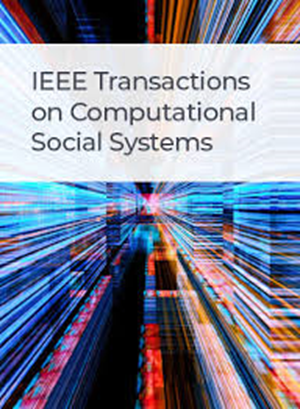网络人群中的信息茧建模:背景和偏好的启示
IF 4.5
2区 计算机科学
Q1 COMPUTER SCIENCE, CYBERNETICS
IEEE Transactions on Computational Social Systems
Pub Date : 2024-03-19
DOI:10.1109/TCSS.2024.3354508
引用次数: 0
摘要
在有限的信息公开和个人偏好的驱动下,信息茧房的形成导致了社会的两极分化。然而,摆脱这些茧的内在机制和途径仍未得到解决。本文旨在通过开发一种适应性模仿过程来解决这一问题。在这一过程中,对整个群体的信息茧的测量是基于香农信息熵,并考虑到邻域信息。结合狄拉克函数来制定网络上的信息分布,并通过数值模拟实验来验证理论结果。结果表明,个人背景和偏好是信息茧形成的关键因素,信息茧产生的严重程度会随着个人坚持自我的能力而增加。鼓励不同社区之间的联系可以有效减轻信息茧的强度。这项研究有助于推动计算通信系统的发展,并为打破信息界限提供了启示。本文章由计算机程序翻译,如有差异,请以英文原文为准。
Modeling Information Cocoons in Networked Populations: Insights From Backgrounds and Preferences
The formation of information cocoons, driven by limited disclosure and individual preferences, has resulted in the polarization of society. However, the underlying mechanisms and pathways to escape these cocoons remain unresolved. This article aims to solve it by developing an adaptive imitation process. In this process, the measurement of information cocoons across the population is based on Shannon's information entropy, taking into account neighborhood information. Incorporating the Dirac function to formulate information distribution over networks, theoretical results are validated by numerical simulation experiments. Results show that individual backgrounds and preferences are crucial factors in the formation of information cocoons, and the severity of information cocoon production increases with an individual capacity to stick to oneself. Encouraging connections among diverse communities can effectively mitigate the intensity of information cocoons. This research contributes to the advancement of computational communication systems and offers insights toward dismantling informational boundaries.
求助全文
通过发布文献求助,成功后即可免费获取论文全文。
去求助
来源期刊

IEEE Transactions on Computational Social Systems
Social Sciences-Social Sciences (miscellaneous)
CiteScore
10.00
自引率
20.00%
发文量
316
期刊介绍:
IEEE Transactions on Computational Social Systems focuses on such topics as modeling, simulation, analysis and understanding of social systems from the quantitative and/or computational perspective. "Systems" include man-man, man-machine and machine-machine organizations and adversarial situations as well as social media structures and their dynamics. More specifically, the proposed transactions publishes articles on modeling the dynamics of social systems, methodologies for incorporating and representing socio-cultural and behavioral aspects in computational modeling, analysis of social system behavior and structure, and paradigms for social systems modeling and simulation. The journal also features articles on social network dynamics, social intelligence and cognition, social systems design and architectures, socio-cultural modeling and representation, and computational behavior modeling, and their applications.
 求助内容:
求助内容: 应助结果提醒方式:
应助结果提醒方式:


